Imagine a world where buildings do more than simply shelter us. Picture spaces that actively boost wellbeing, save energy, and adapt to every need, all thanks to smart building sensors. In 2025, this is not science fiction but a growing reality across industries.
This article delves into how smart building sensors are transforming environments for facility managers, business owners, and innovators. We will reveal seven of the most innovative applications, supported by data and real cases, that show the true power of this technology.
Ready to discover smarter, greener, and safer spaces? Let us explore what is possible.
The Evolution of Smart Building Sensors
Smart building sensors have transformed how we understand and manage the built environment. In 2025, these devices are far more advanced than their early counterparts. Today, a smart building sensor can be environmental, occupancy, air quality, energy, or security focused. Each type gathers specific data, but what sets them apart is their integration with IoT, AI, and modern building management systems. Since 2020, we have seen significant leaps in sensor miniaturisation, battery life, and real-time analytics. For example, AI-powered multi-sensor devices in contemporary offices now manage several building systems in unison. For a deeper look at these technologies, the Smart sensor technology overview provides a thorough introduction.
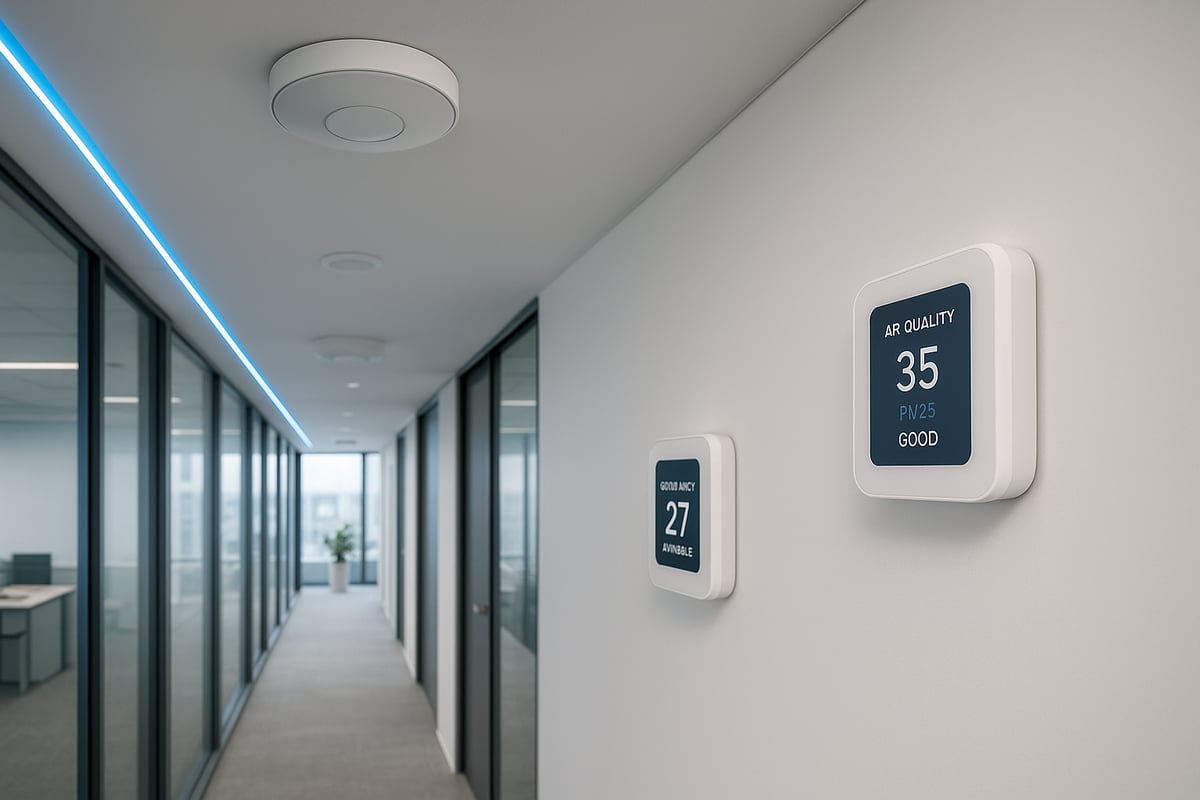
Defining Smart Building Sensors
In 2025, smart building sensors are devices that monitor and transmit data on everything from temperature and humidity to movement and air quality. There are many sensor types, including environmental, occupancy, air quality, energy, and security. These sensors are fully integrated with IoT networks, AI algorithms, and building management platforms for seamless control. The latest advancements include AI-powered multi-sensor hubs that combine several functions in a single device, streamlining installation and management. For example, in modern office spaces, one smart sensor can track air quality, occupancy, and energy use simultaneously, delivering real-time insights to facility managers.
Market Growth and Adoption Trends
The smart building sensors market has experienced rapid expansion. In 2024, the global market reached $24.66 billion, with a projected compound annual growth rate of 10.78 percent through 2034. This surge is driven by rising demand in commercial, educational, and public sector buildings. Key drivers include the need for energy efficiency, meeting sustainability mandates, improving occupant wellbeing, and reducing operational costs. Deployment rates are highest in new builds, but retrofitting is also increasing as organisations seek smart upgrades. These trends signal a future where smart building sensors are standard in all property types.
Core Benefits of Smart Building Sensors
One of the leading advantages of smart building sensors is their ability to provide real-time data and actionable insights. This enables more efficient energy management, which translates to lower operational costs. Occupant comfort, health, and productivity are also improved through optimised lighting, air quality, and temperature controls. Automated compliance with health and safety regulations becomes straightforward. A UK office building case study demonstrated significant energy savings and measurable improvements in staff wellbeing after deploying a comprehensive sensor system. These benefits make sensor investments attractive for a range of facilities.
Key Challenges and Considerations
Despite their advantages, smart building sensors present several challenges. Data privacy and security remain top concerns, particularly with the volume of sensitive information collected. Integrating new sensors with legacy building systems can be complex and may require specialised expertise. Upfront costs are often significant, so organisations must weigh these against long-term return on investment. Staff training and change management are crucial to a successful rollout, ensuring smooth adoption and ongoing value. Finally, regulatory compliance and adherence to evolving standards must be factored into every deployment.
7 Innovative Uses for Smart Building Sensors in 2025
Smart building sensors are transforming the way we interact with built environments in 2025. Their advanced capabilities are driving efficiency, comfort, and safety across sectors. Let us explore seven cutting-edge applications that are redefining the possibilities for facility managers, business owners, and innovators.
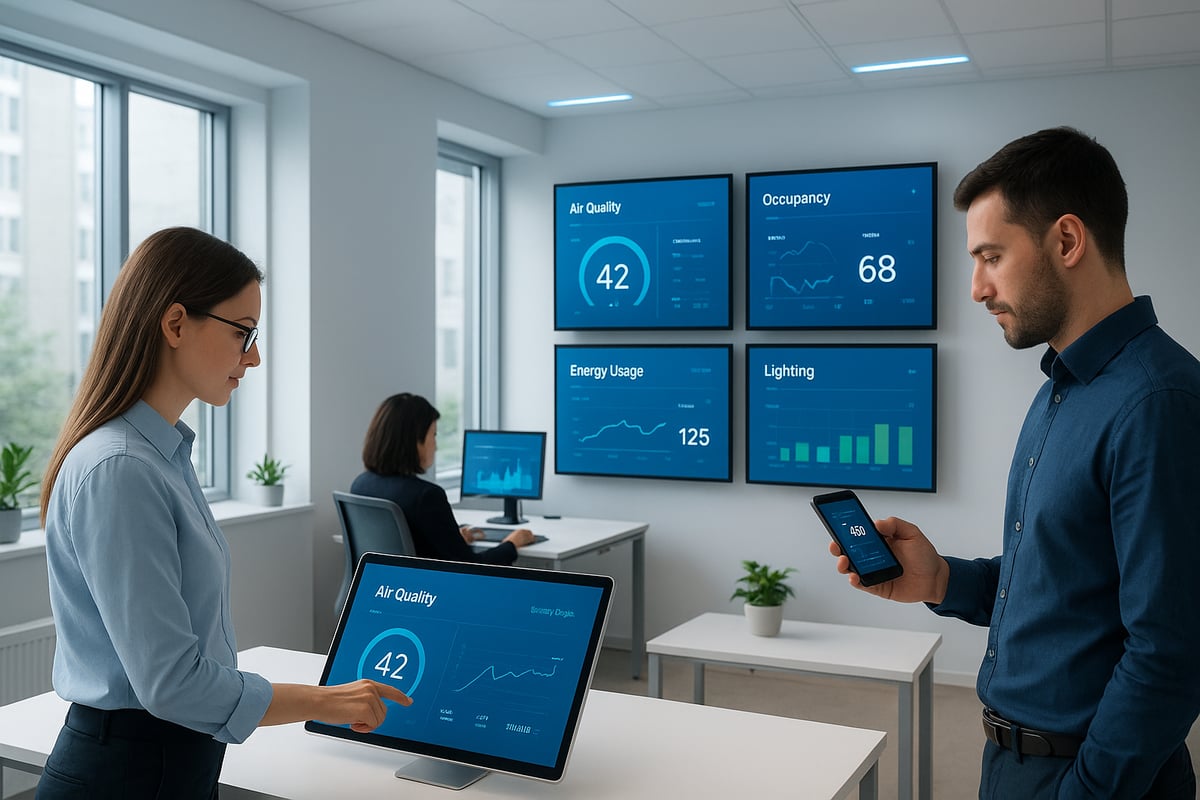
1. Predictive Maintenance and Asset Management
Predictive maintenance is one of the most valuable uses of smart building sensors in 2025. Sensors continuously monitor critical infrastructure, including HVAC systems, lifts, plumbing, and electrical components. By capturing data on vibration, temperature, and electrical load, these sensors provide early warnings of potential faults.
Artificial intelligence analyses this sensor data to predict equipment failures before they happen. For example, vibration and temperature sensors installed on water pumps can detect minute anomalies that indicate wear, prompting maintenance teams to act before a breakdown occurs.
Real-time alerts and automated maintenance schedules are sent directly to facility managers. This proactive approach minimises unplanned downtime, reduces repair costs, and extends the lifespan of expensive assets. Data-driven insights from smart building sensors also support capital planning and budgeting, as trends in equipment performance and failure can be tracked over time.
Industry statistics show that predictive maintenance powered by smart building sensors can reduce unplanned outages by up to 50 percent. Commercial real estate and manufacturing facilities are leading the adoption of these solutions, finding that the investment quickly pays off in operational savings and reliability.
With smart building sensors, asset management becomes more strategic, efficient, and cost-effective, allowing teams to focus on higher-value activities rather than emergency repairs.
2. Advanced Occupancy and Space Utilisation Analytics
Smart building sensors are revolutionising space management through real-time occupancy analytics. Occupancy sensors now track the use of meeting rooms, workstations, and communal areas, providing accurate, up-to-the-minute data on how spaces are being used.
This information allows facility managers to dynamically allocate space, optimise hot-desking arrangements, and tailor cleaning schedules to actual usage. For example, universities leverage smart building sensors to monitor lecture hall occupancy, ensuring rooms are used efficiently and resources are not wasted.
By integrating with booking systems, these sensors enable seamless experiences for users, who can easily find and reserve available spaces. In hybrid work environments, occupancy data supports flexible office layouts and adapts to changing workforce patterns.
Energy savings are another key benefit. Smart building sensors automatically dim lights and adjust HVAC in unused areas, reducing waste. Studies report up to a 30 percent reduction in underutilised space in buildings that deploy these analytics.
The end result is a smarter, more responsive workplace. Occupants enjoy improved comfort and productivity, while organisations benefit from lower operational costs and more sustainable use of their real estate.
3. Adaptive Energy Management and Sustainability
Energy management is at the core of sustainable building operations, and smart building sensors are driving significant improvements in this area. Environmental sensors continuously track temperature, humidity, CO2, and light levels throughout the facility.
Automated systems use this data to adjust heating, ventilation, air conditioning, and lighting in real time, responding instantly to changes in occupancy or weather. For instance, office buildings are now able to reduce peak energy loads by using sensor-driven automation that pre-cools or pre-heats spaces only when needed.
Participation in demand response programmes is also enabled by smart building sensors, supporting grid stability and reducing energy costs during periods of high demand. These sensors provide the data required for robust ESG reporting and help organisations achieve sustainability goals.
Industry insights demonstrate that adaptive energy management using smart building sensors can cut building energy use by 10 to 25 percent. Compliance with green certifications such as BREEAM and LEED is also streamlined thanks to automated tracking and reporting.
With data-driven strategies powered by smart building sensors, facilities can plan long-term improvements, reduce their environmental footprint, and deliver measurable cost savings.
4. Enhanced Indoor Air Quality and Health Monitoring
Ensuring healthy indoor air quality has become a top priority, and smart building sensors are essential to achieving this goal in 2025. Advanced sensors monitor CO2, volatile organic compounds (VOCs), particulate matter, and humidity in real time.
Automated ventilation systems respond instantly to spikes in pollutants or changes in occupancy, maintaining optimal air quality at all times. Schools, for example, use smart building sensors to keep classrooms safe and well-ventilated, a critical measure post-pandemic.
The benefits extend beyond health. Improved indoor air quality is linked to an 8 to 11 percent increase in productivity and reduced absenteeism. Sensors also trigger alerts when air filters need replacement, ensuring maintenance is timely and effective.
Integration with public health dashboards brings transparency, allowing stakeholders to see real-time air quality data. For a comprehensive overview of how these systems work, see the Indoor air quality sensors guide.
Smart building sensors make it easier to comply with health and safety standards, supporting wellbeing initiatives and demonstrating a commitment to occupant care.
5. Intelligent Security and Safety Automation
Security is a critical concern for any facility, and smart building sensors are elevating protection to new heights. Motion, contact, and acoustic sensors detect unauthorised access, broken windows, and unusual sounds, providing comprehensive coverage without the need for constant human oversight.
When a security event is detected, smart building sensors trigger automated responses such as lockdowns, alarms, and emergency lighting. Hospitals now use these systems to restrict access to sensitive areas, preventing unauthorised entry and safeguarding patients and staff.
Integration with CCTV and access control systems creates a multi-layered security approach. Real-time notifications are sent to security teams and building managers, enabling rapid response to incidents. Data logs generated by smart building sensors support incident investigation and compliance with regulatory requirements.
Industry data shows that sensor-driven security systems reduce false alarms and improve response times, enhancing both safety and peace of mind for occupants. With smart building sensors, facilities can maintain high standards of security without increasing operational complexity.
6. Personalised Comfort and User Experience
Personalisation is at the forefront of modern building design, and smart building sensors are making tailored environments the norm. Sensors in each zone monitor occupancy, temperature, lighting, and air quality, allowing for customisable settings based on individual or group preferences.
Occupants can adjust their environment using mobile apps or building interfaces, creating spaces that support productivity and wellbeing. Hotels, for example, use smart building sensors to offer guests bespoke room conditions, adjusting lighting and temperature automatically according to preference and presence.
These personalised experiences are especially valuable for supporting neurodiverse needs and wellbeing initiatives. Smart building sensors also provide valuable analytics to inform future design and fit-out decisions, ensuring spaces evolve with user expectations.
Integrating smart furniture and wearables further enhances the user experience. Studies indicate that personalised environments enabled by smart building sensors can improve occupant satisfaction by up to 20 percent, increasing retention and strengthening brand reputation.
7. Water Leak and Environmental Hazard Detection
Protecting property and occupants from environmental hazards is another vital application of smart building sensors. These devices detect water leaks, flooding, gas, smoke, and other hazardous conditions as soon as they arise.
Immediate alerts are sent to facility teams, allowing for rapid intervention and minimising damage. Retail centres, for instance, use underfloor leak sensors to prevent costly water damage, with smart building sensors automatically activating shut-off valves when a leak is detected.
Automated system shutdowns and detailed event logs support insurance claims and risk assessments, while ensuring compliance with safety regulations. Early detection can reduce water damage costs by over 80 percent, making smart building sensors a wise investment for commercial, residential, and critical infrastructure settings.
The versatility of smart building sensors ensures that environmental hazards are managed proactively, safeguarding assets and supporting resilient operations.
Integrating Smart Building Sensors with AI and IoT Platforms
Smart building sensors are transforming the way facilities operate in 2025. Their integration with AI and IoT platforms enables buildings to react intelligently, providing real-time insights and automation for better outcomes. Seamless connectivity, robust security, and forward-thinking strategies are now essential for maximising the value of sensor investments.

Seamless Data Integration and Analytics
Effective data integration is at the heart of smart building sensors. Sensors communicate with building management systems and cloud platforms to centralise information. AI and machine learning analyse this data, uncovering patterns and providing actionable insights for facilities teams.
Real-time dashboards present live sensor data, helping managers respond quickly to any changes in occupancy, air quality, or energy demand. For instance, AI-driven systems can automatically optimise HVAC and lighting by learning occupancy patterns, resulting in both comfort and efficiency.
By connecting smart building sensors to IoT networks, buildings become more responsive and adaptive. This seamless integration reduces manual intervention and speeds up decision making, making operations smoother and more reliable.
Cybersecurity and Data Privacy in Sensor Networks
As smart building sensors collect sensitive data, robust cybersecurity measures are crucial. Secure communication protocols such as BACnet and MQTT help protect data as it travels between devices and management systems. Encryption and strict user access controls ensure only authorised personnel can access information.
Compliance with regulations like GDPR is essential for protecting occupant privacy. Many facilities now use privacy-first occupancy monitoring, which avoids cameras and instead relies on non-intrusive sensors. This approach balances the need for actionable insights with ethical considerations.
By prioritising security and privacy, organisations build trust with occupants and stakeholders, ensuring that the benefits of smart building sensors are realised without compromising data integrity.
Challenges and Best Practices for Implementation
Implementing smart building sensors in existing sites can be complex, especially when retrofitting older systems. Ensuring interoperability between devices from different manufacturers is a common challenge, as is training staff to manage new technologies.
To address these issues, facility managers should consider phased rollouts and pilot projects. This approach minimises risk and allows for gradual adoption. Ongoing budgeting for maintenance and upgrades is also vital to ensure long-term performance.
| Challenge | Best Practice |
|---|---|
| Integration with legacy systems | Choose open standards and protocols |
| Staff training | Provide ongoing education |
| Device compatibility | Test interoperability before rollout |
| Budgeting | Include life cycle costs |
By following these best practices, organisations can maximise the benefits of smart building sensors and create a future-ready environment.
Future Trends in Smart Building Sensors
The future of smart building sensors is rapidly evolving. Multi-sensor devices that combine air quality, occupancy, and security functions are becoming standard. Integration with digital twins and advanced simulation tools is expanding, allowing for more accurate planning and optimisation.
New sectors such as healthcare, retail, and logistics are adopting these technologies, driven by the need for real-time responsiveness and improved outcomes. Edge computing is also gaining traction, enabling faster local decision making without relying on the cloud.
Recent projections indicate that the deployment of smart building sensors will accelerate, with billions of devices expected worldwide by 2030. For further insights on market growth and future opportunities, explore the global smart building market growth statistics.
Smart building sensors are now platforms for continuous innovation, supporting sustainability, occupant wellbeing, and operational excellence.
Smart Building Sensor Selection: What Facility Managers Need to Know
Selecting the right smart building sensors is a critical step for facility managers aiming to future proof their properties. The right choice will not only enhance operational efficiency but also support occupant wellbeing, compliance, and sustainability goals.
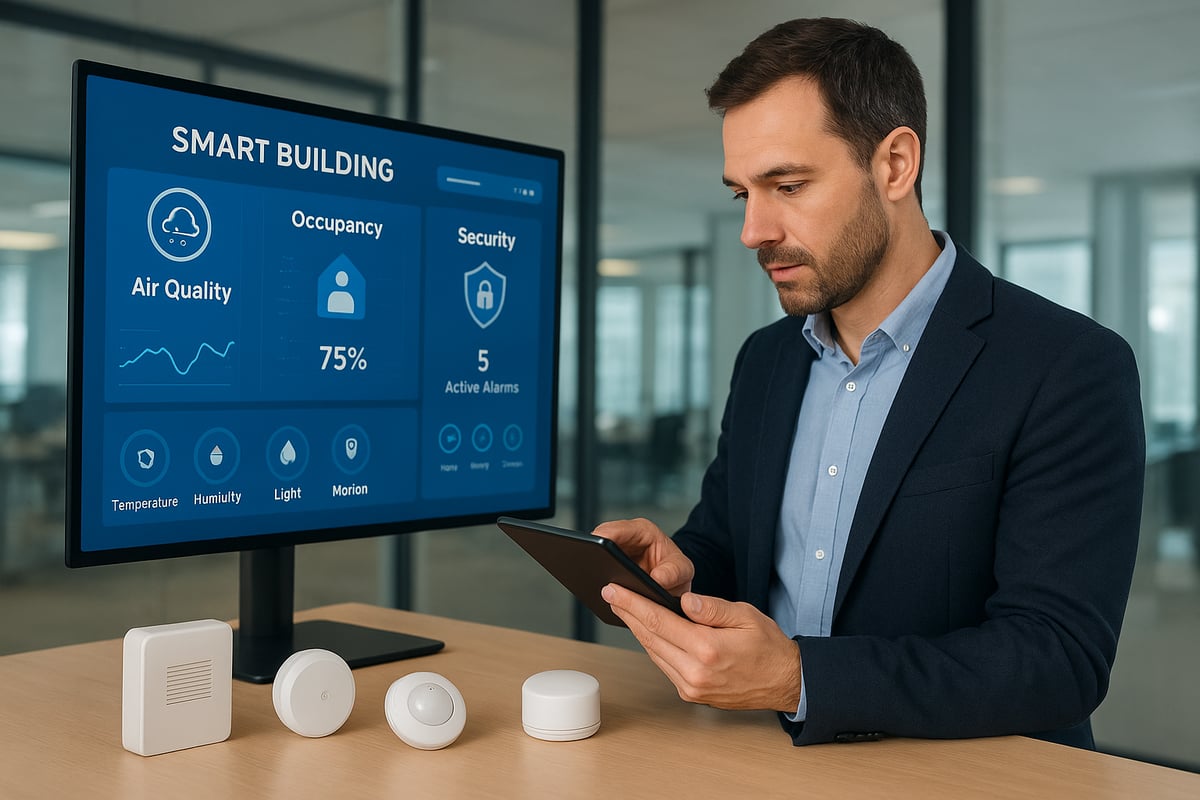
Assessing Organisational Needs and Goals
Begin by identifying your organisation’s most pressing challenges. Are you seeking to reduce energy costs, improve compliance, boost occupant comfort, or strengthen security? Map these objectives directly to the capabilities of smart building sensors.
Gather input from key stakeholders such as operations, IT, and health and safety teams. Define clear, measurable KPIs that align with your strategic vision. For example, educational institutions may prioritise air quality monitoring and vaping detection to support student wellbeing. By aligning sensor investments with specific goals, you maximise both impact and return on investment.
Comparing Sensor Types and Technologies
Smart building sensors come in several categories, each offering unique benefits. Consider environmental, occupancy, security, air quality, and leak detection sensors. Evaluate whether wired or wireless sensors best suit your building’s layout and infrastructure.
Integration with existing building management systems and IoT platforms is essential for seamless operation. To streamline your selection process, review detailed comparisons such as the Best vape detector and sensors comparison, which highlights performance, reliability, and maintenance needs. A multi sensor approach in mixed use developments often delivers the most value and flexibility.
| Sensor Type | Key Function | Ideal Use Case |
|---|---|---|
| Environmental | Temp, humidity | Offices, schools |
| Occupancy | Space utilisation | Commercial, public |
| Security | Access monitoring | Hospitals, retail |
| Air Quality | Health, wellbeing | Education, offices |
| Leak Detection | Risk mitigation | Residential, retail |
Budgeting, Procurement, and Vendor Evaluation
Assess the total cost of ownership for your smart building sensors. This includes hardware, software, installation, and ongoing support. Compare vendor reputation, support services, and upgrade pathways to ensure a smooth procurement process.
Seek out free trials, pilot programmes, and guarantees to validate sensor performance before a full rollout. For example, predictive maintenance sensors can yield significant cost savings by reducing unplanned outages. When negotiating contracts, clarify data ownership, privacy, and service level agreements to safeguard your organisation’s interests.
Ensuring Long Term Value and Scalability
Plan for expansion and future upgrades when deploying smart building sensors. Choose solutions that support regular software and firmware updates, ensuring ongoing security and feature enhancements.
Monitor sensor performance using analytics dashboards and adjust strategies as needed. Build a roadmap for continuous improvement, collaborating with vendors and industry partners to stay ahead of regulatory and technological changes. Scalability is key, as your building’s needs may evolve over time, and a flexible sensor ecosystem will support long term success.
As we’ve explored, smart building sensors are transforming how we manage energy, safety, and occupant wellbeing—paving the way for safer, healthier environments in 2025 and beyond. If you’re interested in how advanced sensor technology can work for your school, office, or leisure space, you don’t have to navigate this journey alone. Vape Guardian is here to support you with innovative solutions that detect vaping, monitor air quality, and promote compliance, all backed by dedicated customer care. If you’re ready to take the next step towards a smarter, safer building, talk to our team and protect your building today.

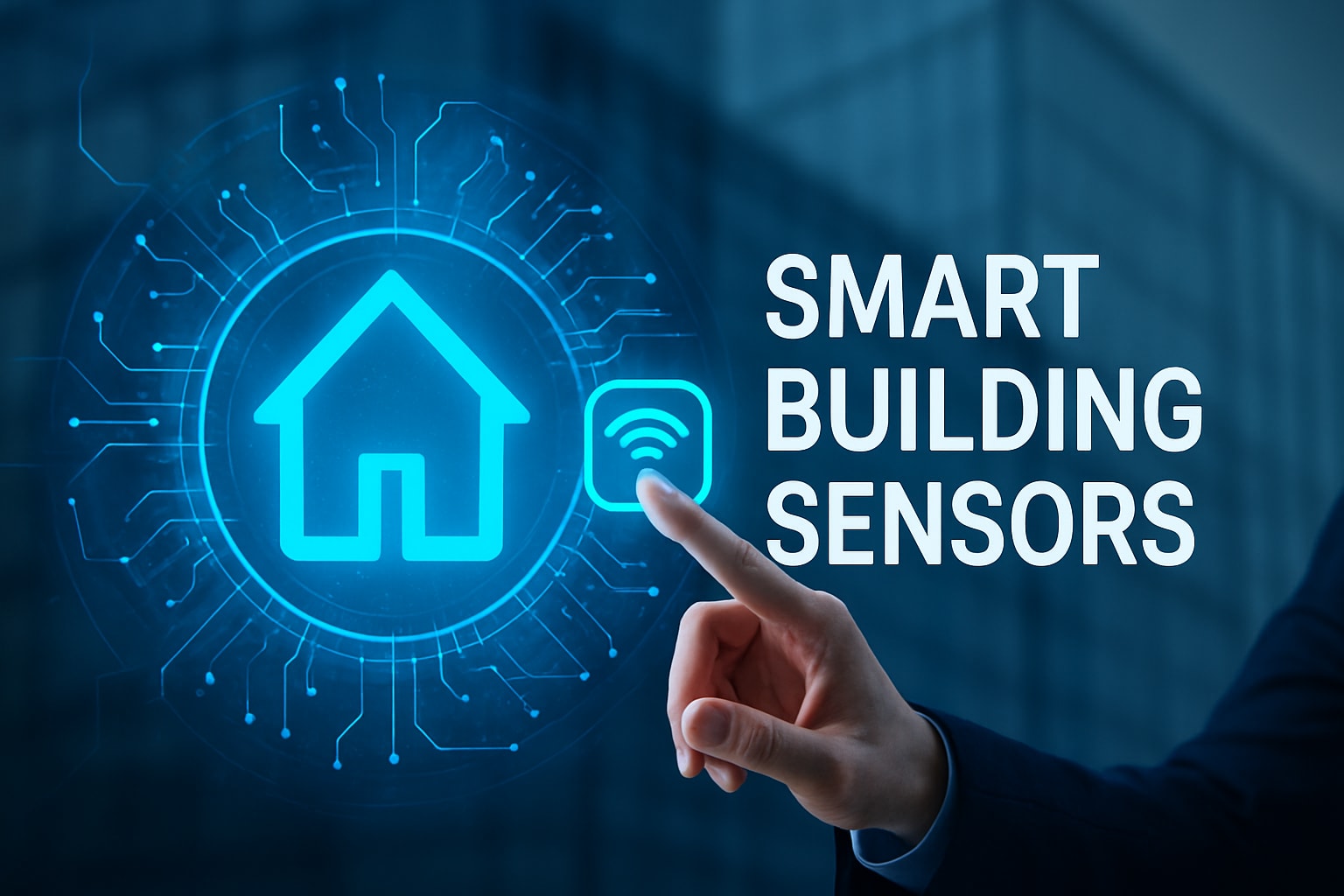
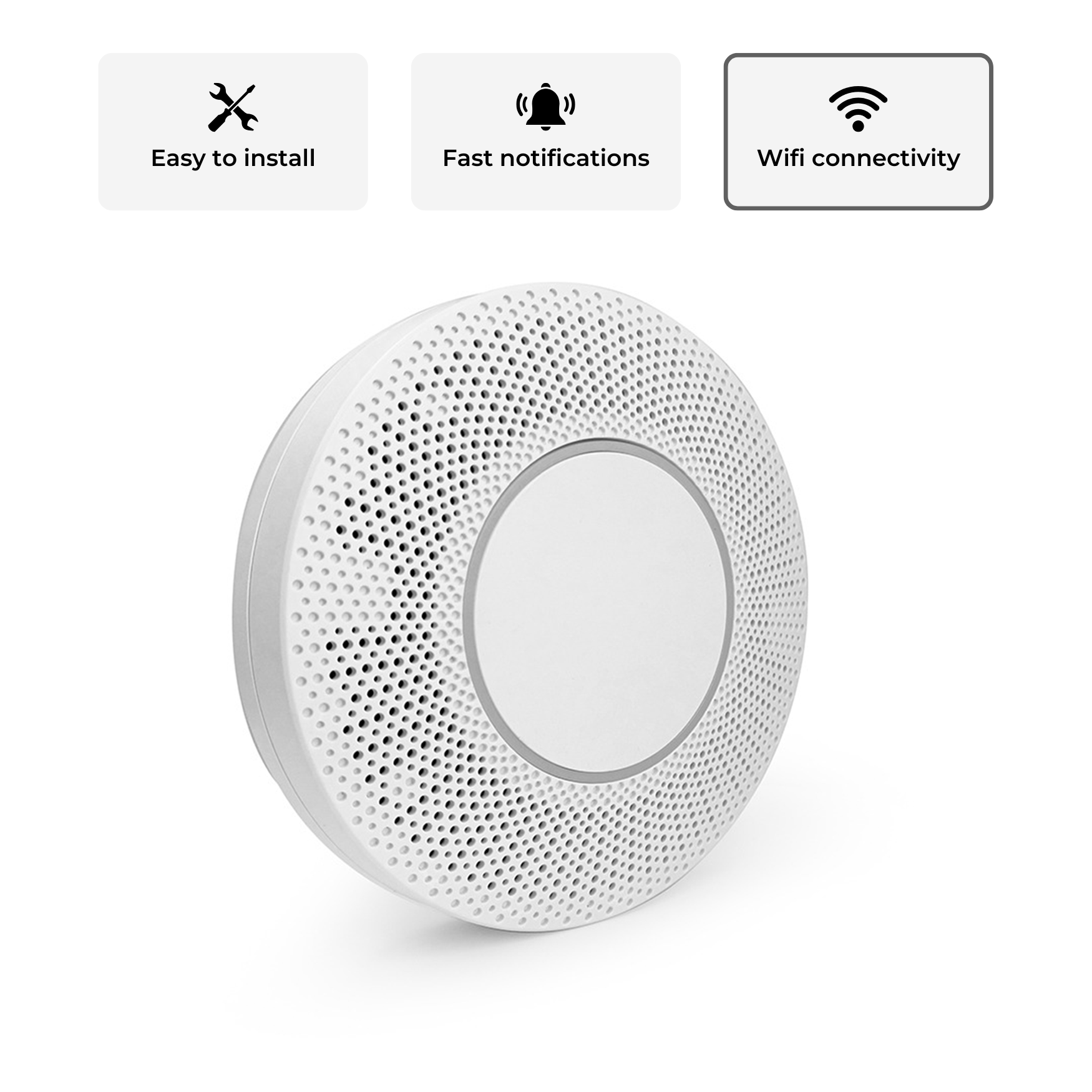
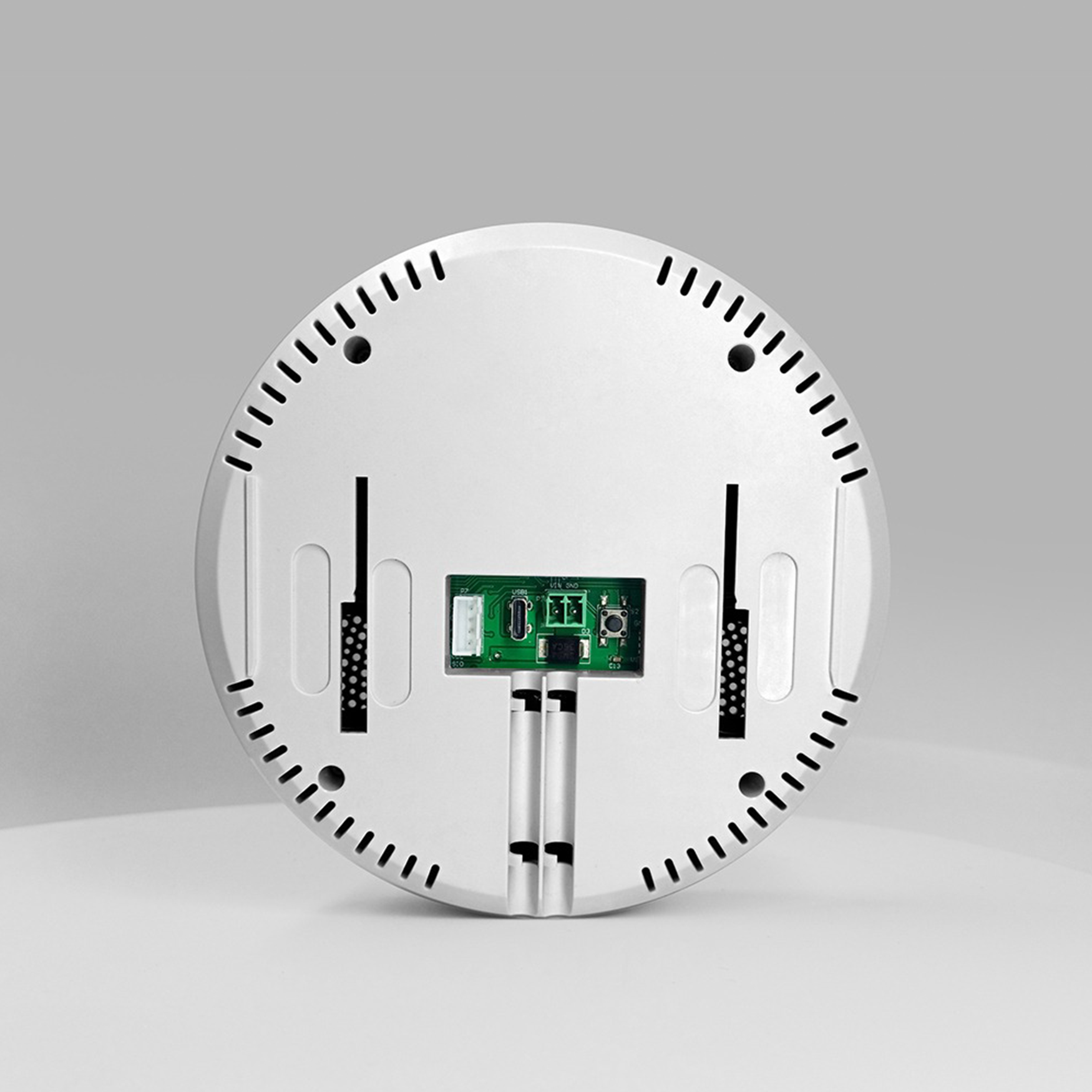

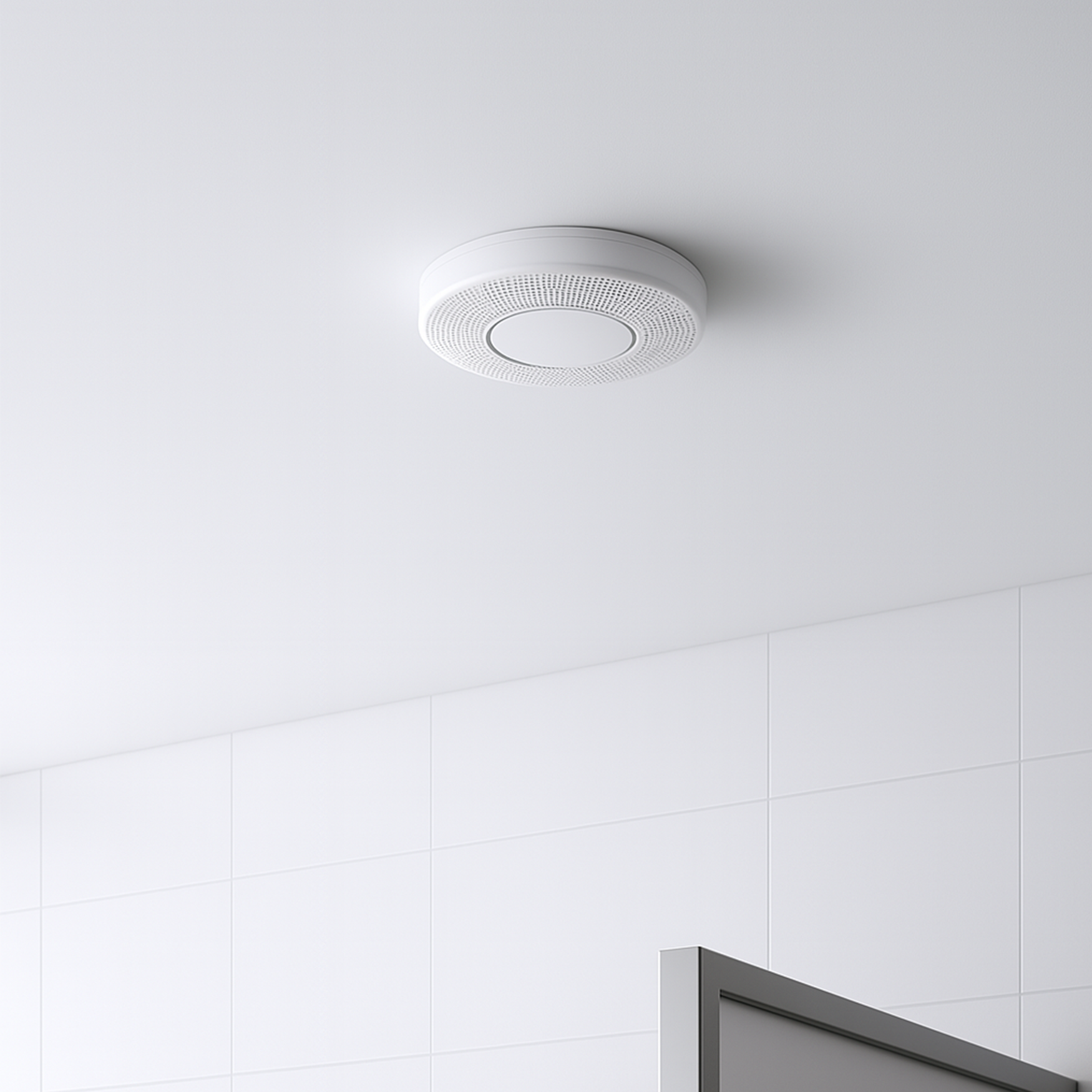
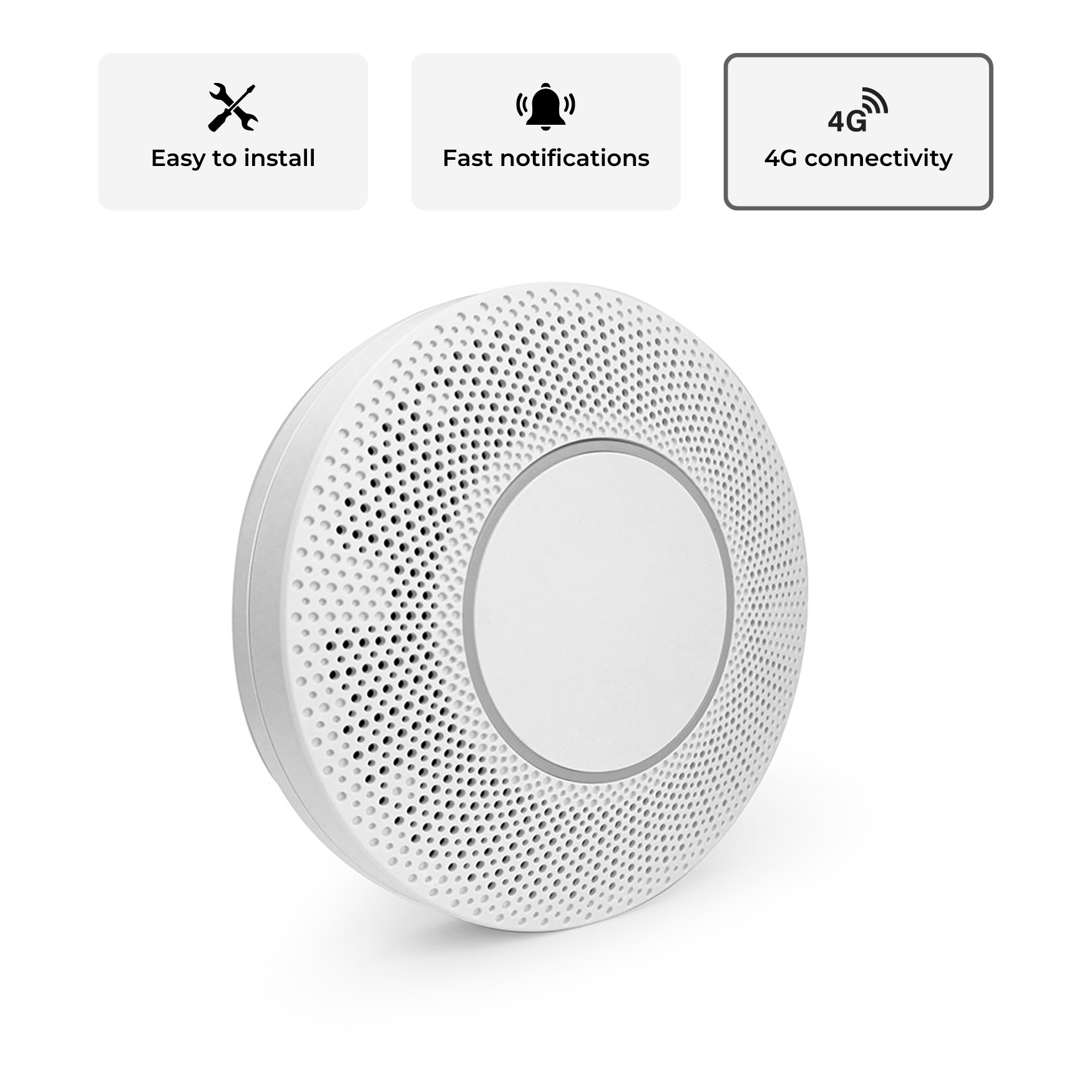
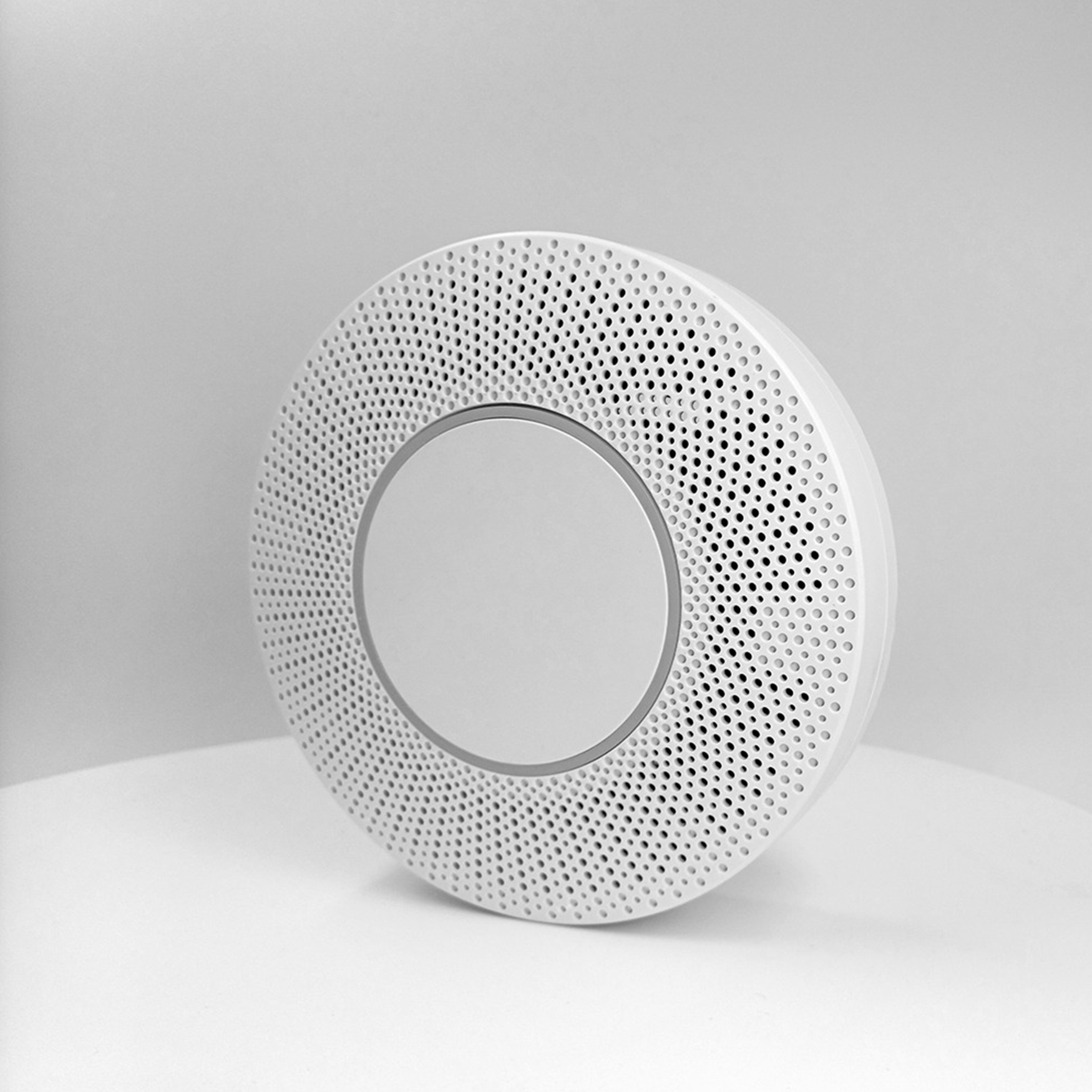
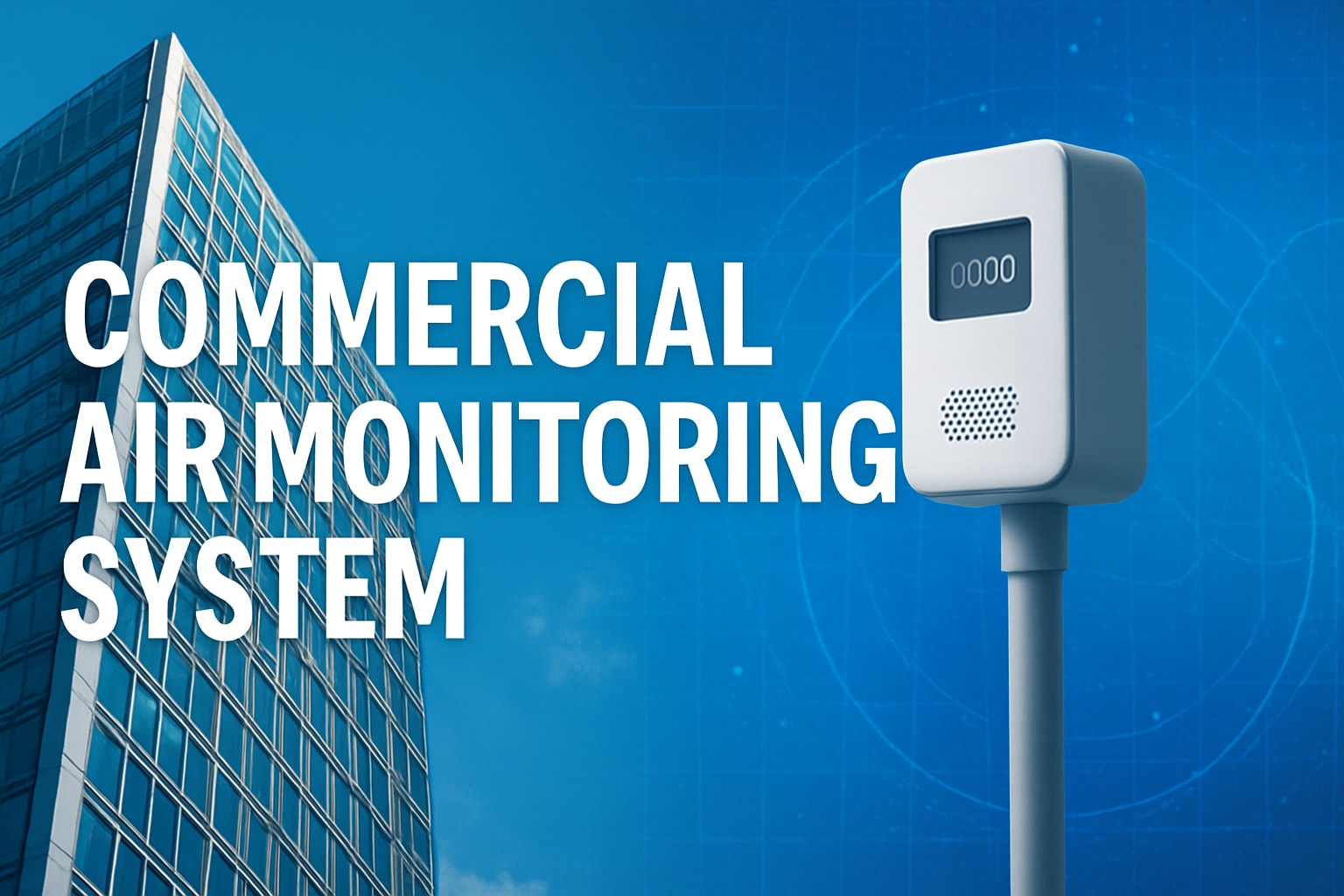


Share:
The Essential Guide to Indoor Air Quality Sensors 2025
Environmental Monitoring System Guide: Best Practices for 2025